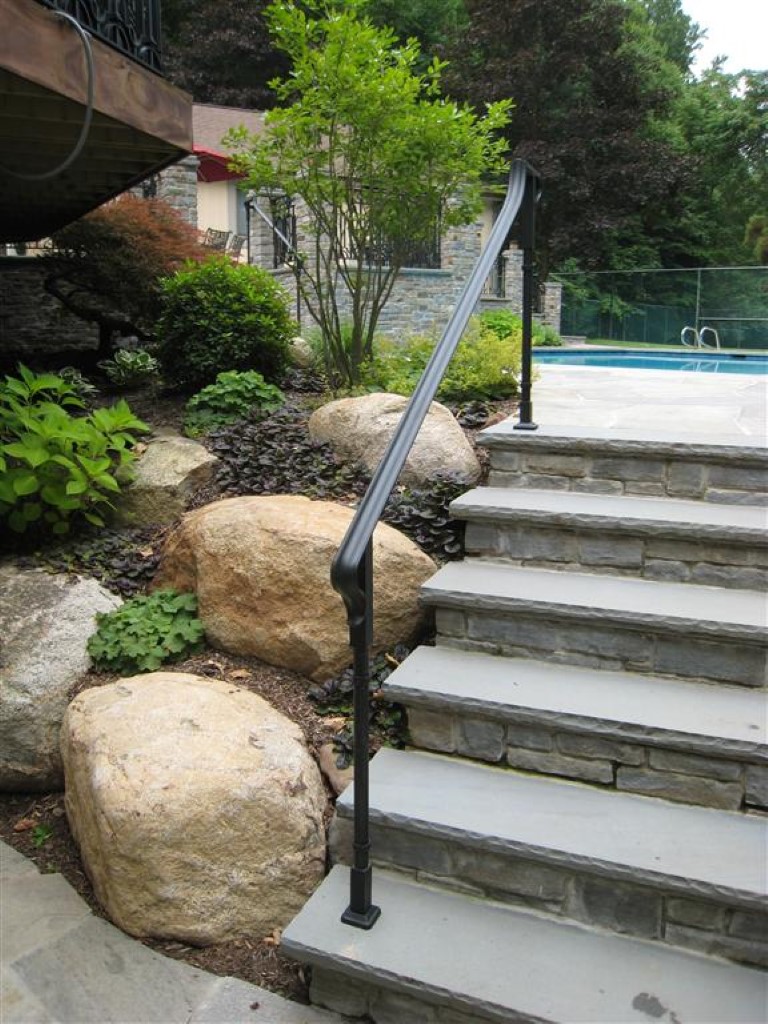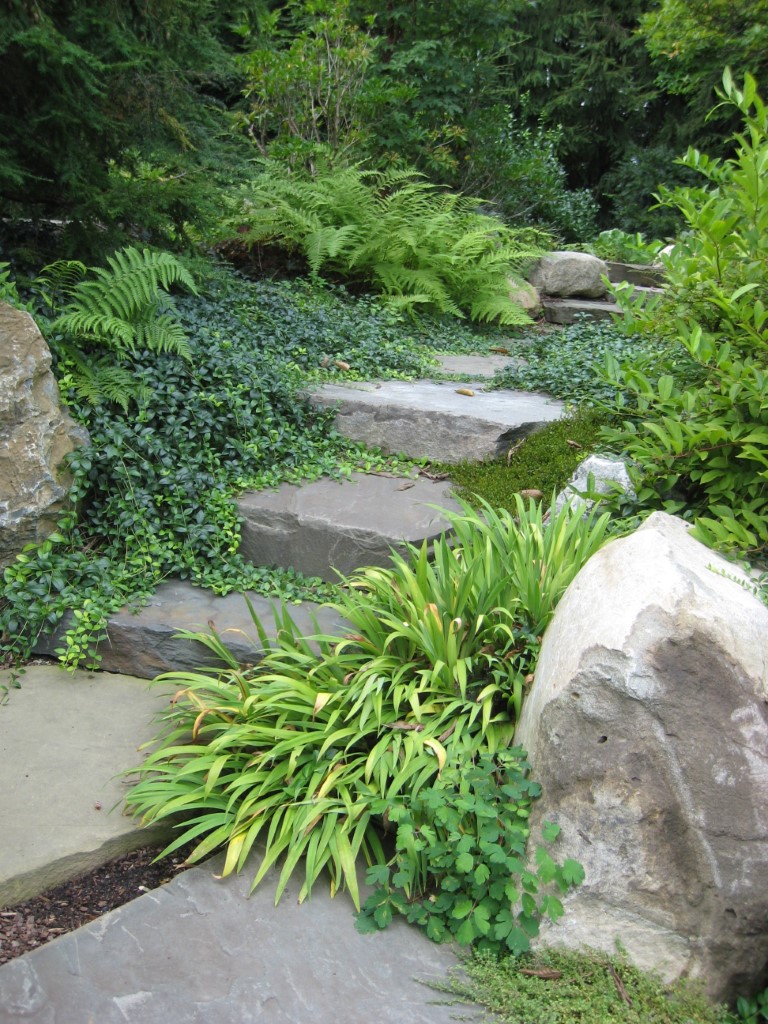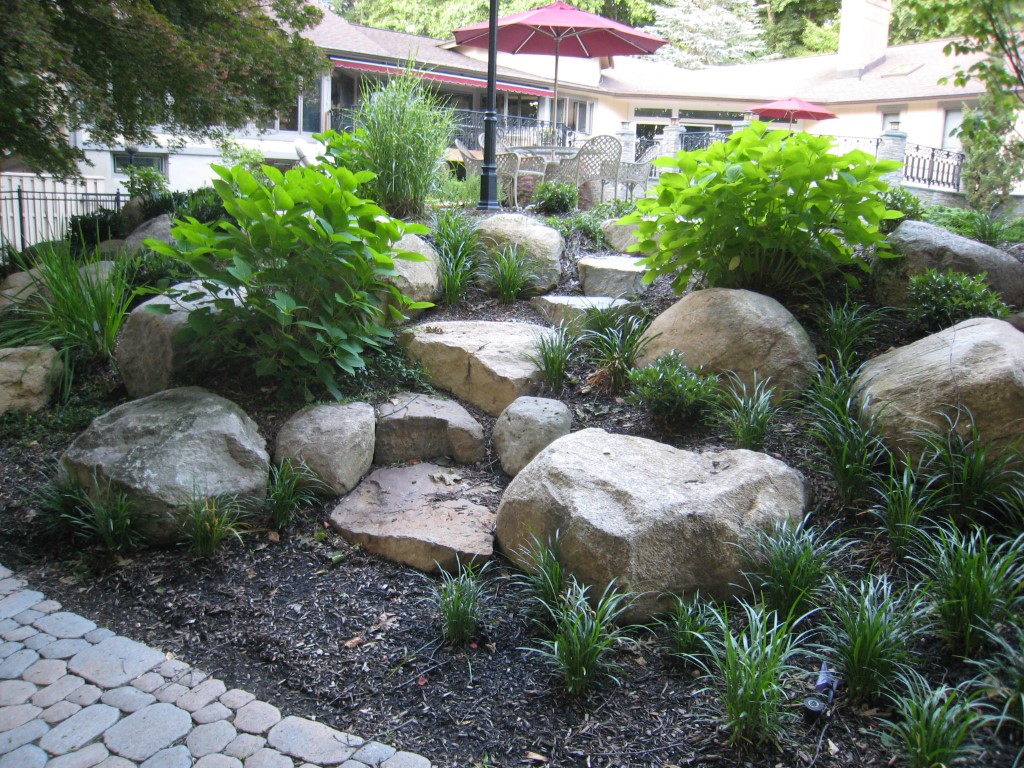Stone steps come in all styles.
In landscape design, how stone steps look is as important as how they function. Frankly, that should be the case of every element in a well-designed landscape.
When we speak of the function for steps, it’s important to realize if these steps are the only option to get from one level to another. Or, are there alternative ways in the design.
And if there are alternative ways, what role of importance will each provide?
If the area to access is important and only one set of steps is used, then they have to conform to the features of any safe and frequently used stairway. In fact, depending on the situation, you may be subject to building code requirements.
In the project pictured above there is a pool and patio level on top, and a cobble-like paver walkway below.
There are 3 alternative ways to get from this lower level to the pool.

1. Near the driveway and where guests would enter the backyard there is a “primary” set of masonry steps with stone veneer risers and bluestone step treads. (pic above) I call them primary because this is the main set of steps to the area.
These masonry steps meet every requirement for safety including a handrail. They did require a construction permit and were inspected.
2. At the other end of the pool/patio, the lower grade was sloped up to meet the patio. This alternate access is grass and allows for an “easy-go” if you’re wheeling something or would just rather not navigate steps.
3. In between the masonry steps and the sloped lawn access we planned to have boulders and plantings to retain the earth. While setting the boulders it came to us to offer a 3rd alternate access for the homeowner. They have children who we thought would love a “rock-climbing-like” step/path down to the cobble walkway. (See the top picture).
The Type Of Stone Step You Build Should Relate To Its Use
Here’s why these “rough” fieldstone steps work:
- they are not the only access
- they provide a novel experience for the young & adventuresome. (Not to say the older folks can’t give them a go too.)
- they add interest to the garden
These “rough” stone steps in the first picture were simply picked out of a stockpile of fieldstone boulders that were delivered. By selecting rocks with flatter sides, “stone steps were born”.
If you wanted to have an informal and natural set of steps, but with a bit more consistency, stone slab-steps are available. As seen in the picture below, these steps are more angular and come from the quarry in slabs.

Although they’re not dimensionally the same, you can request certain size ranges and that helps with building stone steps to fit your plan and vision.
To make the rise-height of each step the same, you can adjust the “setting bed” (usually gravel) to make the stone sit higher or lower.
There are other techniques which involve cutting the stone with a diamond blade to make it fit the situation.
Stone step design is only limited by your imagination.


Randy
How do you charge for steps like this?
Roger
Randy,
Pricing is a topic unto itself, and of course alot has to do with your operation (I’m assuming you run a business by your question).
Most companies have formulas that allow them to measure linear feet of step and multiply that by a unit cost. These unit cost formulas evolve over time where you keep track of a an entire specific task (e.g. building a stone slab-step stairway) and note every aspect of the task. You keep track of every bit of time, equipment, labor and materials associated with that task (and I mean every). Do this analysis several times on similar tasks and you start to get a sense of what this kind of work entails “fairly consistently”. Break it down into “units” (square footage, linear footage, etc.) and you should be able to come up with a cost/unit.
This is assuming, of course, you know your costs for doing business and therefore know how to price the aspects of your involvement accordingly (i.e. man hour, equipment costs, overhead, etc.) and make a profit. Your accountant could definitely help on this. Make sure you have all the data from your analysis on the task, like I mentioned above, and sit down with your accountant. Together I’m sure you’ll come up with a formula.
Once you have a unit cost and are using it in your pricing, continue to keep track on these tasks and check the outcome. Compare the actual costs you incur against the price you gave the homeowner and see if it’s working out in terms of profit. This is called “job costing”. If it’s not, adjust your unit cost so you’re profitable.
Some of the real slab steps that are dimensionally similar are pretty consistent with installation involvement, so pricing on those (once you’ve done your pricing homework) is fairly reliable.
On the other hand, the rough boulder steps in the first picture of the article are so random in shape and how you arrange them, it’s hard to estimate the cost. Ideally you should do this kind of work as “time & materials”. If you must give a price, break the work down into phases. Be very thorough to include every task and aspect relating to the work. Write these tasks and aspects down as a chronological list (as if you were doing the work). Maybe consult with your foreman – discuss every aspect and award the necessary time, equipment and material cost for each task. If you can (and I suggest you do) add something on (5%, 8% ?) as a buffer.
Again, if you get the job and do it, keep track (job-cost) and see how you did. Eventually, and with experience, you get to know your production capabilities and you get more confident with pricing like this.
I might have rambled a bit on this one, but pricing is a broad topic:)
Take care,
Roger
Chris
Thanks for giving me this idea. I have a slope that steps like this will work great on. I’d even consider doing it myself, but these rocks must be heavy. Any ideas on how I could handle them?
Roger
Chris,
I have to tell you, most of the stones you see in this article were handled by machine (i.e. mini-excavator, mid-sized excavator, skid steer). That’s not to say you can’t “caveman” certain sized rocks into position. By choosing rocks and boulders that are more manageable in size, with wheelbarrows, hand-trucks, pry bars and any other leverage aids you can do some amazing things. Since the size of the rocks will be smaller, try grouping them to create a larger scale, massive look. The steps might end up being a grouping of 2 or 3 rocks to create one step – and that can work fine.
If you really want to use large rocks and boulders, you could rent a mini-excavator. If so, tell the rental yard what you intend to do and have an idea of how heavy the largest rock might be. Lift capacity is a factor as the machine will have a limit to how much it can lift. You’ll end up using either chains and/or nylon straps to “cradle” the rocks into position.
Chris, this is not easy to do for the inexperienced, and because you would be working with heavy weight and machinery, I’d think carefully about tackling this job yourself at this level. Perhaps try the method with smaller rocks and working by hand first; if the results are disappointing maybe you can hire a machine and its operator to assist you.
Roger
RTaylor
where can I find the handrail pictured in the stone boulder steps?
Roger
RTaylor,
The handrail was made by a local ornamental railing company. You probably have one (or several) in your area.
Companies like this will fabricate just about about type of railing you want. They typically have pictures and/or samples you can pick from to mix and match to get the look you want. They then measure your steps (or wherever you need the railing) and build to those specifications.